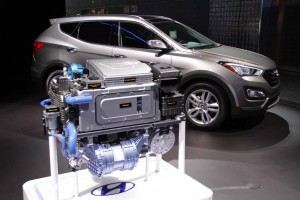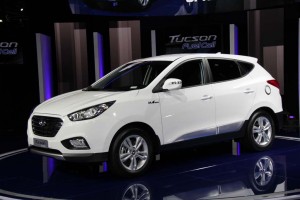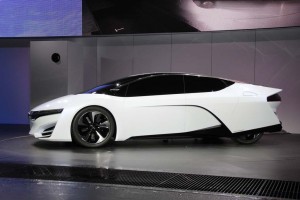Hyundai will launch U.S. sales of its first hydrogen fuel cell vehicle next spring – and the maker hopes to fire up the market for the zero-emission technology by offering a $499-a-month lease that will include the cost of fueling up the alternative vehicle.
The launch of the Hyundai Tucson Fuel Cell Vehicle will come about a year ahead of when both Toyota and Honda have said they will put their own hydrogen cars into production. Other manufacturers, including General Motors, have suggested they could also launch their own fuel-cell vehicles later in the decade.
“It feels like a coming-out party for hydrogen at the show this week,” said Hyundai Motor America CEO John Krafcik following the unveiling of the Tucson crossover vehicle during the first day of press previews for the 2013 L.A. Auto Show.

The Hyundai fuel cell stack shown in front of the Tucson. The entire package fits under the hood where a gas engine would normally go.
That’s a significant reversal of fortune for fuel-cell technology. Hydrogen power became the darling of environmentalists and regulators early in the new Millennium because the technology can provide plenty of power while producing nothing but water vapor in its exhaust. But a variety of challenges – notably including the lack of a hydrogen production and distribution infrastructure – let many advocates to subsequently shift focus to such alternatives as battery power.
(Hyundai nixes a U.S. diesel in favor of hydrogen, batteries and advanced gas engines. Click Here for the full story.)
But as it has become clear that batteries have their own issues – notably limited range, high costs and long recharging times – hydrogen has regained some of its luster.
That’s not to say all the problems with the technology have been solved. There are still just a handful of places to fill up on the ultra-light gas in the entire country, though proponents have been encouraged to see a number of governments kick-starting the process. California – where Hyundai and other fuel cell carmakers intend to focus initially – hopes to have as many as 100 hydrogen stations in place before 2020, the state coming up with an investment of $20 million annually to subsidize the program.
That could help minimize what Krafcik called the biggest “chicken-and-egg” problem. But there are other issues. Fuel cell “stacks” rely on precious and extremely expensive metals such as platinum to cause a catalytic reaction – combining hydrogen and oxygen from the air to produce current and that water vapor. Hyundai, however, says it has trimmed the cost of its latest fuel cell stack by half over the last two years, according to executive Mike O’Brien, largely by reducing the amount of platinum needed.
(White House wants to scale back biofuels mandate. Click Here for more.)
Meanwhile, the size of the latest stack has shrunk to the point where the entire powertrain can be squeezed in under the hood of the Tucson, just like a gas engine. Hyundai also says it has slashed the noise normally associated with fuel cell technology by eliminating the whining air compressor used by many competitors.
There are other issues, including onboard storage, but Hyundai – like its rivals – is content that the latest stage of development is refined enough to make a hydrogen car like the Tucson Fuel Cell Vehicle practical for at least some consumers.
“Our goal,” said O’Brien, is to get consumers to see that this vehicle can replace the gasoline vehicle they have in their garage right now.”
It helps that a tank of the gas should yield up to 300 miles range. Only the Tesla Model S comes close – and the majority of the latest battery cars are lucky to yield 90 miles on a charge. Refueling a fuel-cell vehicle, or FCV, takes about three minutes – comparable to a gas fill-up – while recharging a battery-electric vehicle can run into the hours.
(VW downplays hydrogen as it launches two new battery cars in LA. Click Here for a closer look.)
Meanwhile, at 134 horsepower and 221 pound-feet of torque the Hyundai Tucson hydrogen car will need about 10 seconds to launch from 0 to 60, or only a second or two slower than the gas-powered version of the ute, according to the Korean carmaker.
Hyundai decided to go with a hydrogen-powered Tucson first because it competes in one of the market’s fastest-growing segments. But O’Brien suggested, “We can place this technology in any size vehicle.”
The maker plans to offer the Tucson FCV on a three-year lease only, requiring a $2,999 downpayment and $499 a month. The vehicle will qualify for a $2,500 credit from the State of California. The price will include all the hydrogen a customer might use, Hyundai announced. And the vehicle will be covered by the same basic valet-style service program as the premium luxury Hyundai Equus model. Dealers will pick the vehicle up, if repairs are needed, and leave a loaner while it’s in the shop.
Officials in Korea have suggested they hope to sell about 1,000 of the Tucson hydrogen cars during its first year on the market, but officials could not say how much of that volume would come from the U.S., Europe – where the FCV is already on sale – or in Korea. Longer-term, said Krafcik, Hyundai is still trying to gauge potential consumer reaction. But as the hydrogen car is being assembled on the same line as other Tucsons, he noted that production could be ramped up substantially to meet higher demand.
Not everyone is convinced the demand will be there. Several carmakers, notably including Volkswagen, have downplayed the technology. And critics contend that the challenges involved with producing hydrogen offset much of the promise energy savings – something proponents debate. But there seems little doubt that after a decade on the backburner, hydrogen power is suddenly cooking with gas.



Looks good, but is it in market yet? Or still in testing?